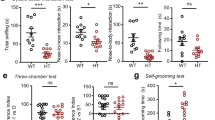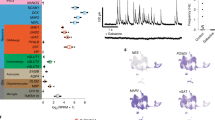Abstract
Transcription regulatory networks governing the genesis, maturation and maintenance of vertebrate brain serotonin (5-HT) neurons determine the level of serotonergic gene expression and signaling throughout an animal's lifespan. Recent studies suggest that alterations in these networks can cause behavioral and physiological pathogenesis in mice. Here, we synthesize findings from vertebrate loss-of-function and gain-of-function studies to build a new model of the transcriptional regulatory networks that specify 5-HT neurons during fetal life, integrate them into CNS circuitry in early postnatal life and maintain them in adulthood. We then describe findings from animal and human genetic studies that support possible alterations in the activity of serotonergic regulatory networks in the etiology of mental illness. We conclude with a discussion of the potential utility of our model, as an experimentally well-defined molecular pathway, to predict and interpret the biological effect of genetic variation that may be discovered in the orthologous human network.
This is a preview of subscription content, access via your institution
Access options
Subscribe to this journal
Receive 12 print issues and online access
$209.00 per year
only $17.42 per issue
Buy this article
- Purchase on Springer Link
- Instant access to full article PDF
Prices may be subject to local taxes which are calculated during checkout




Similar content being viewed by others
References
Gaddum, J.H. Drugs antagonistic to 5-hydroxytryptamine. in Ciba Foundation Symposium on Hypertension, 75–77 (Little, Brown and Co., 1954).
Woolley, D.W. & Shaw, E. A biochemical and pharmacological suggestion about certain mental disorders. Proc. Natl. Acad. Sci. USA 40, 228–231 (1954).
Muller, C.P. & Jacobs, B.L. Handbook of the Behavioral Neurobiology of Serotonin (Academic Press, 2010).
Ishimura, K. et al. Quantitative analysis of the distribution of serotonin-immunoreactive cell bodies in the mouse brain. Neurosci. Lett. 91, 265–270 (1988).
Baker, K.G. et al. Cytoarchitecture of serotonin-synthesizing neurons in the pontine tegmentum of the human brain. Synapse 7, 301–320 (1991).
Hornung, J.P. The human raphe nuclei and the serotonergic system. J. Chem. Neuroanat. 26, 331–343 (2003).
Gaspar, P., Cases, O. & Maroteaux, L. The developmental role of serotonin: news from mouse molecular genetics. Nat. Rev. Neurosci. 4, 1002–1012 (2003).
Goridis, C. & Rohrer, H. Specification of catecholaminergic and serotonergic neurons. Nat. Rev. Neurosci. 3, 531–541 (2002).
Cordes, S.P. Molecular genetics of the early development of hindbrain serotonergic neurons. Clin. Genet. 68, 487–494 (2005).
Scott, M.M. & Deneris, E.S. Making and breaking serotonin neurons and autism. Int. J. Dev. Neurosci. 23, 277–285 (2005).
Fernandez, S.P. & Gaspar, P. Investigating anxiety and depressive-like phenotypes in genetic mouse models of serotonin depletion. Neuropharmacology 62, 144–154 (2012).
Kim, H. et al. Serotonin regulates pancreatic beta cell mass during pregnancy. Nat. Med. 16, 804–808 (2010).
Flames, N. & Hobert, O. Transcriptional control of the terminal fate of monoaminergic neurons. Ann. Rev. Neurosci. 34, 153–184 (2011).
Ben-Tabou de-Leon, S. & Davidson, E.H. Gene regulation: gene control network in development. Annu. Rev. Biophys. Biomol. Struct. 36, 191 (2007).
Azmitia, E.C. & Gannon, P.J. The primate serotonergic system: a review of human and animal studies and a report on Macaca fascicularis. Adv. Neurol. 43, 407–468 (1986).
Lidov, H.G.W. & Molliver, M.E. Immunohistochemical study of the development of serotonergic neurons in the rat CNS. Brain Res. Bull. 9, 559–604 (1982).
Lillesaar, C., Tannhauser, B., Stigloher, C., Kremmer, E. & Bally-Cuif, L. The serotonergic phenotype is acquired by converging genetic mechanisms within the zebrafish central nervous system. Dev. Dyn. 236, 1072–1084 (2007).
Wallace, J.A. & Lauder, J.M. Development of the serotonergic system in the rat embryo: an immunocytochemical study. Brain Res. Bull. 10, 459–479 (1983).
Steinbusch, H.W.M. Distribution of serotonin-immunoreactivity in the central nervous system of the rat-cell bodies and terminals. Neuroscience 6, 557–618 (1981).
Jensen, P. et al. Redefining the serotonergic system by genetic lineage. Nat. Neurosci. 11, 417–419 (2008).
Pattyn, A. et al. Coordinated temporal and spatial control of motor neuron and serotonergic neuron generation from a common pool of CNS progenitors. Genes Dev. 17, 729–737 (2003).
Lidov, H.G. & Molliver, M.E. An immunohistochemical study of serotonin neuron development in the rat: ascending pathways and terminal fields. Brain Res. Bull. 8, 389–430 (1982).
Briscoe, J. et al. Homeobox gene Nkx2.2 and specification of neuronal identity by graded Sonic Hedgehog signaling. Nature 398, 622–627 (1999).
Pattyn, A. et al. Ascl1/Mash1 is required for the development of central serotonergic neurons. Nat. Neurosci. 7, 589–595 (2004).
Craven, S.E. et al. Gata2 specifies serotonergic neurons downstream of sonic hedgehog. Development 131, 1165–1173 (2004).
Jacob, J. et al. Transcriptional repression coordinates the temporal switch from motor to serotonergic neurogenesis. Nat. Neurosci. 10, 1433–1439 (2007).
Jacob, J. et al. Insm1 (IA-1) is an essential component of the regulatory network that specifies monoaminergic neuronal phenotypes in the vertebrate hindbrain. Development 136, 2477–2485 (2009).
van Doorninck, J.H. et al. GATA-3 is involved in the development of serotonergic neurons in the caudal raphe nuclei. J. Neurosci. 19, RC12 (1999).
Hendricks, T., Francis, N., Fyodorov, D. & Deneris, E. The ETS domain factor Pet-1 is an early and precise marker of central 5-HT neurons and interacts with a conserved element in serotonergic genes. J. Neurosci. 19, 10348–10356 (1999).
Pfaar, H. et al. mPet-1, a mouse ETS-domain transcription factor, is expressed in central serotonergic neurons. Dev. Genes Evol. 212, 43–46 (2002).
Cheng, L. et al. Lmx1b, Pet-1 and Nkx2.2 coordinately specify serotonergic neurotransmitter phenotype. J. Neurosci. 23, 9961–9967 (2003).
Pattyn, A., Hirsch, M., Goridis, C. & Brunet, J.F. Control of hindbrain motor neuron differentiation by the homeobox gene Phox2b. Development 127, 1349–1358 (2000).
Kaestner, K.H. The FoxA factors in organogenesis and differentiation. Curr. Opin. Genet. Dev. 20, 527–532 (2010).
Hirsch, M.R., Tiveron, M.C., Guillemot, F., Brunet, J.F. & Goridis, C. Control of noradrenergic differentiation and Phox2a expression by MASH1 in the central and peripheral nervous system. Development 125, 599–608 (1998).
Ding, Y.Q. et al. Lmx1b is essential for the development of serotonergic neurons. Nat. Neurosci. 6, 933–938 (2003).
Tsai, F.Y. et al. An early haematopoietic defect in mice lacking the transcription factor GATA-2. Nature 371, 221–226 (1994).
Krueger, K.C. & Deneris, E.S. Serotonergic transcription of human FEV reveals direct GATA factor interactions and fate of Pet-1–deficient serotonin neuron precursors. J. Neurosci. 28, 12748–12758 (2008).
Hobert, O., Carrera, I. & Stefanakis, N. The molecular and gene regulatory signature of a neuron. Trends Neurosci. 33, 435–445 (2010).
Dai, J.X., Johnson, R.L. & Ding, Y.Q. Manifold functions of the Nail-Patella Syndrome gene Lmx1b in vertebrate development. Dev. Growth Differ. 51, 241–250 (2009).
Zhao, Z.Q. et al. Lmx1b is required for maintenance of central serotonergic neurons and mice lacking central serotonergic system exhibit normal locomotor activity. J. Neurosci. 26, 12781–12788 (2006).
Osterberg, N. et al. Sim1 is a novel regulator in the differentiation of mouse dorsal raphe serotonergic neurons. PLoS ONE 6, e19239 (2011).
Demarque, M. & Spitzer, N.C. Activity-dependent expression of Lmx1b regulates specification of serotonergic neurons modulating swimming behavior. Neuron 67, 321–334 (2010).
Liu, C. et al. Pet-1 is required across different stages of life to regulate serotonergic function. Nat. Neurosci. 13, 1190–1198 (2010).
Lima, F.B. et al. Stress sensitive female macaques have decreased fifth Ewing variant (Fev) and serotonin-related gene expression that is not reversed by citalopram. Neuroscience 164, 676–691 (2009).
Maurer, P. et al. The ETS transcription factor Fev is specifically expressed in the human central serotonergic neurons. Neurosci. Lett. 357, 215–218 (2004).
Iyo, A.H., Porter, B., Deneris, E.S. & Austin, M.C. Regional distribution and cellular localization of the ETS-domain transcription factor, FEV, mRNA in the human postmortem brain. Synapse 57, 223–228 (2005).
Hendricks, T.J. et al. Pet-1 ETS gene plays a critical role in 5-HT neuron development and is required for normal anxiety-like and aggressive behavior. Neuron 37, 233–247 (2003).
Kiyasova, V. et al. A genetically defined morphologically and functionally unique subset of 5-HT neurons in the mouse raphe nuclei. J. Neurosci. 31, 2756–2768 (2011).
Wylie, C.J. et al. Distinct transcriptomes define rostral and caudal serotonin neurons. J. Neurosci. 30, 670–684 (2010).
Scott, M.M. et al. A genetic approach to access serotonin neurons for in vivo and in vitro studies. Proc. Natl. Acad. Sci. USA 102, 16472–16477 (2005).
Schmid, C., Schwarz, V. & Hutter, H. AST-1, a novel ETS-box transcription factor, controls axon guidance and pharynx development in C. elegans. Dev. Biol. 293, 403–413 (2006).
Livet, J. et al. ETS gene PEA3 controls the central position and terminal arborization of specific motor neuron pools. Neuron 35, 877–892 (2002).
Arber, S., Ladle, D.R., Lin, J.H., Frank, E. & Jessell, T.M. ETS gene Er81 controls the formation of functional connections between group Ia sensory afferents and motor neurons. Cell 101, 485–498 (2000).
Jacobsen, K.X., Czesak, M., Deria, M., Le Francois, B. & Albert, P.R. Region-specific regulation of 5-HT1A receptor expression by Pet-1–dependent mechanisms in vivo. J. Neurochem. 116, 1066–1076 (2011).
Bonnin, A., Peng, W., Hewlett, W. & Levitt, P. Expression mapping of 5-HT1 serotonin receptor subtypes during fetal and early postnatal mouse forebrain development. Neuroscience 141, 781–794 (2006).
Albert, P.R., Le Francois, B. & Millar, A.M. Transcriptional dysregulation of 5-HT1A autoreceptors in mental illness. Mol. Brain 4, 21 (2011).
Song, N.N. et al. Adult raphe-specific deletion of lmx1b leads to central serotonin deficiency. PLoS ONE 6, e15998 (2011).
Holmes, A. Genetic variation in cortico-amygdala serotonin function and risk for stress-related disease. Neurosci. Biobehav. Rev. 32, 1293–1314 (2008).
Waider, J., Araragi, N., Gutknecht, L. & Lesch, K.P. Tryptophan hydroxylase-2 (TPH2) in disorders of cognitive control and emotion regulation: a perspective. Psychoneuroendocrinology 36, 393–405 (2011).
Murphy, D.L. et al. How the serotonin story is being rewritten by new gene-based discoveries principally related to SLC6A4, the serotonin transporter gene, which functions to influence all cellular serotonin systems. Neuropharmacology 55, 932–960 (2008).
Beaulieu, J.M. et al. Role of GSK3 beta in behavioral abnormalities induced by serotonin deficiency. Proc. Natl. Acad. Sci. USA 105, 1333–1338 (2008).
Richardson-Jones, J.W. et al. Serotonin-1A autoreceptors are necessary and sufficient for the normal formation of circuits underlying innate anxiety. J. Neurosci. 31, 6008–6018 (2011).
Alenina, N. et al. Growth retardation and altered autonomic control in mice lacking brain serotonin. Proc. Natl. Acad. Sci. USA 106, 10332–10337 (2009).
Hariri, A.R. & Holmes, A. Genetics of emotional regulation: the role of the serotonin transporter in neural function. Trends Cogn. Sci. 10, 182–191 (2006).
Lesch, K.P. et al. Association of anxiety-related traits with a polymorphism in the serotonin transporter gene regulatory region. Science 274, 1527–1531 (1996).
Wendland, J.R. et al. A novel, putative gain-of-function haplotype at SLC6A4 associates with obsessive-compulsive disorder. Hum. Mol. Genet. 17, 717–723 (2008).
Caspi, A. et al. Influence of life stress on depression: moderation by a polymorphism in the 5-HTT gene. Science 301, 386–389 (2003).
Bennett, A.J. et al. Early experience and serotonin transporter gene variation interact to influence primate CNS function. Mol. Psychiatry 7, 118–122 (2002).
Prasad, H.C. et al. Human serotonin transporter variants display altered sensitivity to protein kinase G and p38 mitogen-activated protein kinase. Proc. Natl. Acad. Sci. USA 102, 11545–11550 (2005).
Sutcliffe, J.S. et al. Allelic heterogeneity at the serotonin transporter locus (SLC6A4) confers susceptibility to autism and rigid-compulsive behaviors. Am. J. Hum. Genet. 77, 265–279 (2005).
Blakely, R.D. Overview: a rare opportunity or just one less reason to be depressed. Neuron 48, 701–702, author reply 705–706 (2005).
Zhang, X. et al. Loss-of-function mutation in tryptophan hydroxylase-2 identified in unipolar major depression. Neuron 45, 11–16 (2005).
Jacobsen, J.P. et al. Deficient serotonin neurotransmission and depression-like serotonin biomarker alterations in tryptophan hydroxylase 2 (Tph2) loss-of-function mice. Mol. Psychiatry published online, doi: 10.1038/mp.2011.50 (3 May 2011).
Bethea, C.L. et al. Effects of citalopram on serotonin and CRF systems in the midbrain of primates with differences in stress sensitivity. J. Chem. Neuroanat. 41, 200–218 (2011).
Dai, J.X. et al. Enhanced contextual fear memory in central serotonin-deficient mice. Proc. Natl. Acad. Sci. USA 105, 11981–11986 (2008).
Erickson, J.T., Shafer, G., Rossetti, M.D., Wilson, C.G. & Deneris, E.S. Arrest of 5-HT neuron differentiation delays respiratory maturation and impairs neonatal homeostatic responses to environmental challenges. Respir. Physiol. Neurobiol. 159, 85–101 (2007).
Erickson, J.T. & Sposato, B.C. Autoresuscitation responses to hypoxia-induced apnea are delayed in newborn 5-HT–deficient Pet-1 homozygous mice. J. Appl. Physiol. 106, 1785–1792 (2009).
Hodges, M.R., Best, S. & Richerson, G.B. Altered ventilatory and thermoregulatory control in male and female adult Pet-1 null mice. Respir. Physiol. Neurobiol. 177, 133–140 (2011).
Hodges, M.R. et al. Defects in breathing and thermoregulation in mice with near-complete absence of central serotonin neurons. J. Neurosci. 28, 2495–2505 (2008).
Hodges, M.R., Wehner, M., Aungst, J., Smith, J.C. & Richerson, G.B. Transgenic mice lacking serotonin neurons have severe apnea and high mortality during development. J. Neurosci. 29, 10341–10349 (2009).
Zhao, Z.Q. et al. Mice lacking central serotonergic neurons show enhanced inflammatory pain and an impaired analgesic response to antidepressant drugs. J. Neurosci. 27, 6045–6053 (2007).
Cummings, K.J. et al. Failed heart rate recovery at a critical age in 5-HT–deficient mice exposed to episodic anoxia: implications for SIDS. J. Appl. Physiol. 111, 825–833 (2011).
Cummings, K.J., Li, A., Deneris, E.S. & Nattie, E.E. Bradycardia in serotonin-deficient Pet-1−/− mice: influence of respiratory dysfunction and hyperthermia over the first two postnatal weeks. Am. J. Physiol. Regul. Integr. Comp. Physiol. 298, R1333–R1342 (2010).
Cummings, K.J., Li, A. & Nattie, E.E. Brainstem serotonin deficiency in the neonatal period: autonomic dysregulation during mild cold stress. J. Physiol. (Lond.) 589, 2055–2064 (2011).
Paulus, E.V. & Mintz, E.M. Developmental disruption of the serotonin system alters circadian rhythms. Physiol. Behav. 105, 257–263 (2012).
Lerch-Haner, J.K., Frierson, D., Crawford, L.K., Beck, S.G. & Deneris, E.S. Serotonergic transcriptional programming determines maternal behavior and offspring survival. Nat. Neurosci. 11, 1001–1003 (2008).
Phillips, P.C. Epistasis: the essential role of gene interactions in the structure and evolution of genetic systems. Nat. Rev. Genet. 9, 855–867 (2008).
Dreyer, S.D. et al. Mutations in LMX1B cause abnormal skeletal patterning and renal dysplasia in nail patella syndrome. Nat. Genet. 19, 47–50 (1998).
Dunston, J.A. et al. The human LMX1B gene: transcription unit, promoter and pathogenic mutations. Genomics 84, 565–576 (2004).
Chen, H. et al. Limb and kidney defects in Lmx1b mutant mice suggest an involvement of LMX1B in human nail patella syndrome. Nat. Genet. 19, 51–55 (1998).
Vollrath, D. et al. Loss-of-function mutations in the LIM-homeodomain gene, LMX1B, in nail-patella syndrome. Hum. Mol. Genet. 7, 1091–1098 (1998).
López-Arvizu, C. et al. Increased symptoms of attention deficit hyperactivity disorder and major depressive disorder symptoms in nail-patella syndrome: potential association with LMX1B loss-of-function. Am. J. Med. Genet. B. Neuropsychiatr. Genet. 156B, 59–66 (2011).
Deneris, E.S. Molecular genetics of mouse serotonin neurons across the lifespan. Neuroscience 197, 17–27 (2011).
Cirulli, E.T. & Goldstein, D.B. Uncovering the roles of rare variants in common disease through whole-genome sequencing. Nat. Rev. Genet. 11, 415–425 (2010).
McClellan, J. & King, M.C. Genetic heterogeneity in human disease. Cell 141, 210–217 (2010).
State, M.W. & Levitt, P. The conundrums of understanding genetic risks for autism spectrum disorders. Nat. Neurosci. 14, 1499–1506 (2011).
Dolmazon, V. et al. Forced expression of LIM homeodomain transcription factor 1b enhances differentiation of mouse embryonic stem cells into serotonergic neurons. Stem Cells Dev. 20, 301–311 (2010).
Tokuyama, Y., Ingram, S.L., Woodward, J.S. & Bethea, C.L. Functional characterization of rhesus embryonic stem cell–derived serotonin neurons. Exp. Biol. Med. (Maywood) 235, 649–657 (2010).
Akil, H. et al. Medicine. The future of psychiatric research: genomes and neural circuits. Science 327, 1580–1581 (2010).
Acknowledgements
We thank R. Blakely (Vanderbilt University) and E. Gilmore (Case Western Reserve University) for valuable discussions and critical comments on the manuscript. Research in the Deneris Lab is supported by grants RO1 MH062723 and the Vanderbilt/NIMH Silvio O Conte Center for Neuroscience Research, P50 MH078028 from the US National Institutes of Health.
Author information
Authors and Affiliations
Corresponding author
Ethics declarations
Competing interests
The authors declare no competing financial interests.
Rights and permissions
About this article
Cite this article
Deneris, E., Wyler, S. Serotonergic transcriptional networks and potential importance to mental health. Nat Neurosci 15, 519–527 (2012). https://doi.org/10.1038/nn.3039
Published:
Issue Date:
DOI: https://doi.org/10.1038/nn.3039
This article is cited by
-
Impact of the circadian nuclear receptor REV-ERBα in dorsal raphe 5-HT neurons on social interaction behavior, especially social preference
Experimental & Molecular Medicine (2023)
-
Potential Plausible Role of Stem Cell for Treating Depressive Disorder: a Retrospective Review
Molecular Neurobiology (2023)
-
TAAR1 dependent and independent actions of the potential antipsychotic and dual TAAR1/5-HT1A receptor agonist SEP-363856
Neuropsychopharmacology (2022)
-
The role of histone modifications: from neurodevelopment to neurodiseases
Signal Transduction and Targeted Therapy (2022)
-
Role of Sonic Hedgehog Signaling Activation in the Prevention of Neurological Abnormalities Associated with Obsessive–Compulsive Disorder
Neurotoxicity Research (2022)



